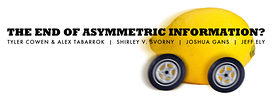I’ve enjoyed this discussion, and it raises two issues I’d like to address. First, Joshua Gans says “it’s not the end of regulation.” But it is important to distinguish between the category of regulation and that of laws that are designed to facilitate market exchange, such as legal penalties to protect market participants when fraud occurs. Increasing penalties for changing a car’s odometer reading fall in the latter category. Market participants benefit from laws that protect them in transactions. These laws reduce the costs of engaging in transactions. Market participants know that they have some legal protection and recourse to court awards that reduce the size of the loss if they trade with a partner who engages in fraud. This reduces the costs of market transactions (such as buying a used car) and facilitates trade. These remedies are not in the same category as government interventions to protect consumers.
Gans seems to have more faith in a government agency when it comes to consumer protection than the market, despite the incentive problems associated with getting government agencies to act in the public interest. He talks about the need for government evaluation of front-loading washing machines, “designed so that with normal use over a number of years mold arises internally.” It is not clear that a government agency would be able to say much about those machines at their introduction, and the market consequences for firms that introduce shoddy products are severe. The evidence from the regulation of physicians is that agencies hide information from the public and fail to identify the majority of malfeasant physicians. Regulatory capture is a well-recognized phenomenon.
Gans suggests employees “who cannot prove they were working rather than shirking” will be sanctioned by a firm, making the workers “vulnerable to rent extraction.” I have to ask why it would be in the interest of the firm to adopt a policy that would tarnish its reputation in the labor market and subject it to potential law suits (for engaging in fraud) to try to extract rents from its employees? That can’t be good for morale, productivity, and profitability over time.
The second issue I’d like to address is Jeff Ely’s statement that, if “the age of asymmetric information is over…the age of markets will be over too.” The market is not simply, as Ely writes, “the most efficient system of collecting and aggregating asymmetric information,” it is much more. In their response, Cowen and Tabarrok point out that the end of asymmetric information is not the end of information costs which, of course, is true. What Ely is missing is that markets do much more than provide information to participants.
Cowen and Tabarrok aptly describe the role of the market’s price mechanism in their microeconomics principles text: “A price is a signal wrapped in an incentive.” In a free market, the price mechanism allocates resources by signaling participants (with prices) and encouraging them to move resources (with market incentives—profits and losses) to shift resources to their highest-valued use (as determined by consumers.) So the age of markets can’t be over unless there is some other, less costly, means to signal and motivate market participants to shift resources in response to changes in consumers’ tastes and preferences.

